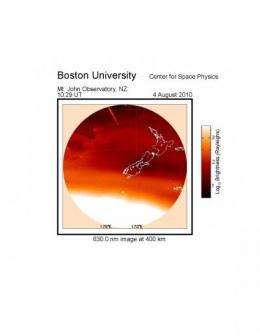Evidence of new solar activity from observations of aurora in New Zealand

Scientists from Boston University's Center for Space Physics (CSP) announced that they have sub-visual evidence of the onset of a new cycle of solar-terrestrial activity. The key results being reported deal with the fact that recent auroral displays at high latitudes (ones visible to the naked eye) were accompanied by far less luminous glows in the atmosphere at lower latitudes.
"It's exciting to see the return of aurora to mid-latitudes," Dr. Steve Smith said, referring to the periodic occurrence of emissions in the Earth's atmosphere that have intrigued observers from ancient to modern times.
What has fascinated space scientists in recent years is the delayed onset of such effects. Typically, the Sun has an activity cycle of about 11 years, with flares and ejections of electrically charged particles (called the solar wind) that cause changes in the Earth's magnetic field that produce, as a side product, luminous emissions in the atmosphere. Such effects are subdued during so-called solar minimum years (e.g., in 1996-1997) and very prominent in solar maximum years (e.g., 2001-2002). Thus, the onset of a new wave of such activity had been expected to be well underway by 2009, but the Sun remained surprisingly quiet. Now, in 2010 there are finally signs of the cycle re-appearing.
The observations made by the BU team used an all-sky camera located at the Mt. John Observatory in Lake Tekapo, New Zealand. "This is essentially a fish-eye lens that is used to view the full sky, and the images are captured with a very sensitive digital CCD camera," explained Jeffrey Baumgardner, who designed and built the instrument.
Smith, who was born in New Zealand and is now a Senior Research Scientist in the BU Center for Space Physics, explained that "The emissions we study come from regions ranging from 200-400 km (125-250 miles) above the surface. These gases are caused to glow by energy input from above, energy that flows downward along the Earth's magnetic field lines."
The curtains of glowing gasses capable of being seen by the human eye are long been called aurora borealis when near polar regions in the northern hemisphere, and aurora australis in southern polar regions. In the accompanying image, the emissions observed come from regions more distant from the poles than where classic aurora occur. These emissions are below naked eye detection limits. The brighter feature far to the south that is captured by the CCD camera is not an example of the classically narrow and dynamic curtain aurora, but of emission far more diffuse in space. They are caused by a steady influx of electrons that hit oxygen atoms and excite them to glow in a typically red light. Separated from it, is an even fainter arc that extends from east to west just south of New Zealand, again captured in the red glow of oxygen atoms. This emission is due to collisions between hot electrons and oxygen atoms in the Earth's ionosphere. Such features are called Stable Auroral Red (SAR) arcs and form an active topic of current research in space physics.
"This image of a SAR arc from New Zealand is perhaps the first-ever case of imaging an unambiguous SAR arc in the southern hemisphere," said Michael Mendillo, Professor of Astronomy at BU.
SAR arcs show where energy from the Van Allen Radiation Belts of electrically charged particles trapped in the Earth's magnetosphere deposits heat into the ionosphere. The narrow dimension of a SAR arc shows that the energy input is confined to a small extent (100 km or 60 miles) in latitude, but in bands that can extend completely around the globe in longitude.
"We fully expect that a similar SAR arc occurred in the northern hemisphere, but it was cloudy at our observatory in Boston that night, and so one was not seen," Smith explained. "We hope in the years ahead to have many cases of SAR arcs in our data from both hemispheres, and then examine the full global distribution of such effects," he added. "Looking to see if the energy input is simultaneously the same or different in each hemisphere is a forefront topic in the study of solar-induced storms in our upper atmosphere."
Provided by Boston University Medical Center




















